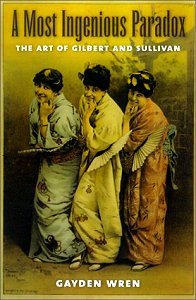The 1980s saw a flourish of G&S books. Things have
been fairly quiet since then until the arrival of this volume. Previous
books, many of the coffee table variety, have attempted to present a
new slant on existing information with few new facts gleaned from a
trawl through numerous museum documents. G&S is strong today with
a Gilbert & Sullivan and Sir Arthur Sullivan Society flourishing
in 2002, not to mention two professional theatre companies in the UK
and numerous amateur productions taking place world-wide. So you thought
you knew all about G & S? – Not so!
Until now few writers have attempted a detailed assessment
of the secret behind the success of the G&S tradition. Gayden Wren
reveals these secrets by exploring and assessing works in an intriguing
way. What we have in A Most Ingenious Paradox is a radically
different treatment, which analyses in depth the structure of each opera,
both in words and music – their thematic structure, interaction of characters,
plot strengths and weaknesses, and the evolution of a style. As a stage
director, Wren clearly knows his G&S from back to front and top
to bottom, yet additionally he shows an extraordinary eye for detail
that is impressive. He is perceptive in matching plot/character similarities,
Gilbert’s evolution of rhyming patterns, and has a good memory for seeking
parallels in the operas. Consequently, Wren succeeds in holding our
attention throughout. It is amazing how much detail can be overlooked
when exposed to G&S from an early age. I thought I knew plot structure
and thematic similarities, but this book makes one aware of unusual
patterns and contradictions that have been staring audiences in the
face and of which they are rarely aware. Readers will view G&S with
fresh eyes.
For instance, we find that the writing structure for
The Sorcerer is found by Wren to be generally discarded in HMS
Pinafore, while much of the character painting in Pinafore
is again thrown aside in The Pirates of Penzance as the writers
fine-tune a formula for the continued success of later operas. Wren
goes into considerable detail to justify this, and his justification
from the examples given makes good sense. Some ideas are revolutionary
and unexpected. It is well documented that after the Iolanthe and
Mikado Sullivan kept pushing Gilbert for more realistic situations
to his plots and characters to portray real emotions. It requires someone
as alert as Wren to make the connection that he had been given all this
in The Pirates. Discussion of the early operas includes the relative
weightings of solo/duet/trio/quartet/chorus numbers to illustrate how
their formula is being perfected. He injects some startling revelations–
Gilbert breaks new ground with Pinafore and Pirates structure
since The Sorcerer’s solo numbers, mainly about love, can be
swapped between operas as they do not develop the plot. Also, flowers
provide the theme running through Ruddigore, while Rose and Margaret
are the antithesis of each other - both engaged in charitable acts they
swap roles between the Acts. The Rose-Margaret dialogue is necessary
to develop Margaret’s character though it does not add to the plot.
In places Wren gets carried away with an idea. I cannot
take seriously his observation of Gilbert’s ‘land agent and ladybird’
remark (Ruddigore), ‘I shall rend you asunder’ being associated
with ‘rents’ and ‘sundry items’. (I notice he steers clear of comment
about ‘a cook’s brainpan like an overwound clock’, Yeomen.) A
few facts like an incorrect performance run of Thespis [80],
disputed by Rees, and picture of a Fifth Avenue first night programme
captioned ‘poster’ were noticed, but it is hardly fair to dwell on such
matters since the real purpose of the book is to survey the operas themselves.
Although perhaps the book is short of good illustrative
material, this 350 page volume contains extras. Appendices of opera
synopses and revisions to Ruddigore are provided with a detailed
list that includes the titles of all songs discussed within the chapters.
Footnotes are good and extensive, and an excellent bibliography provides
a critical assessment (with which I would agree) of some G&S books
published in America. This is an American OUP publication so expect
‘theater’ and ‘gotten’, etc. but do the Americans really spell ‘ambience’
as ‘ambiance’? (A better gilt-tooled hardback cover would have been
appreciated.)
Wren is a gifted writer and gives his honest views
with confidence, providing clear style of presentation, clarity of description
and much to get one thinking.
Raymond J Walker


